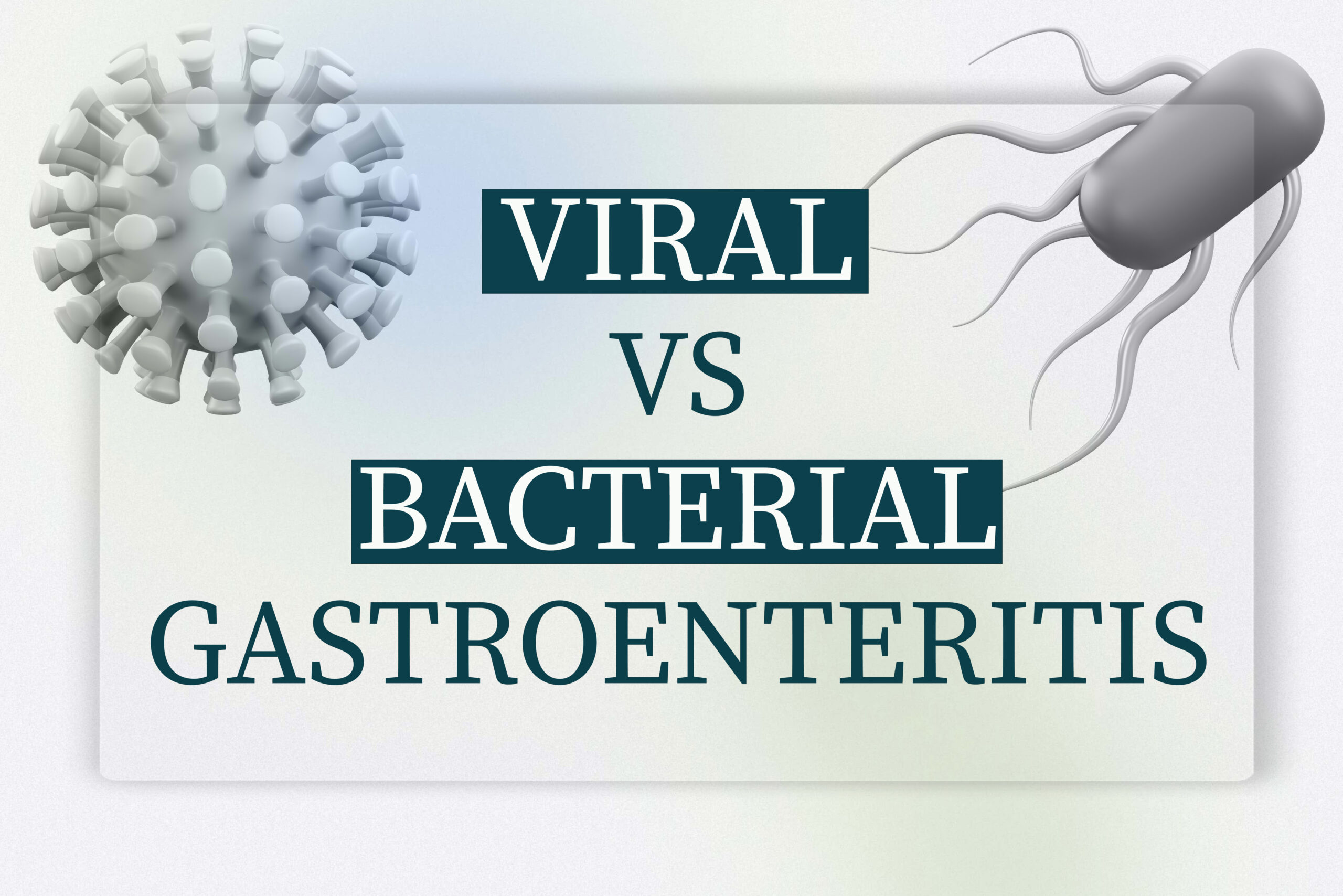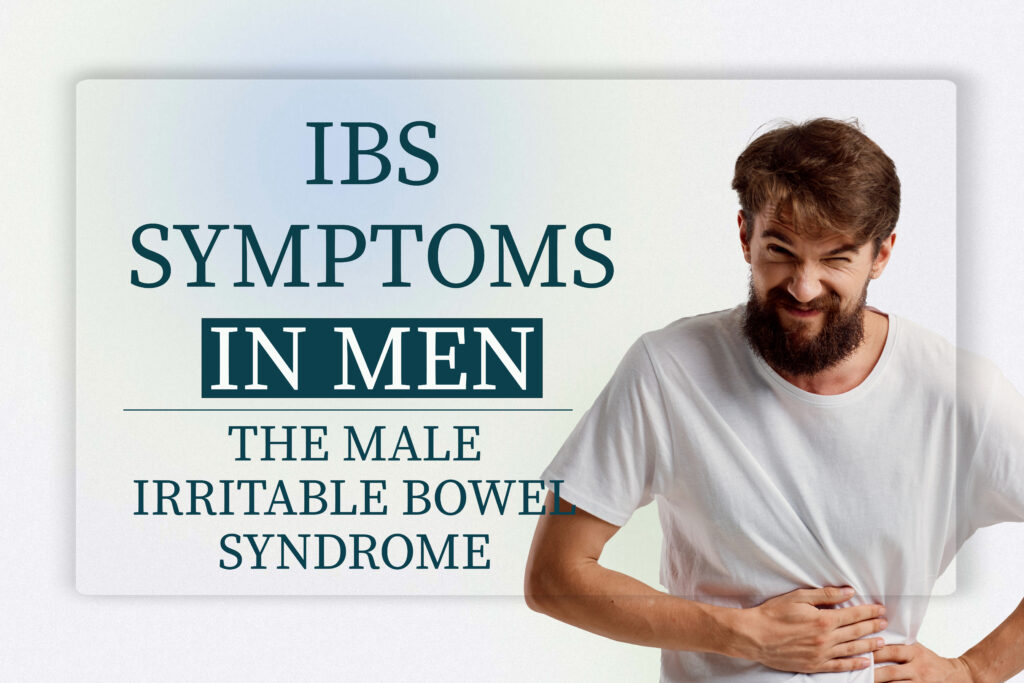Viral vs bacterial gastroenteritis
A complete guide
In this guide, you’ll learn how viral vs bacterial gastroenteritis differ—from common causes to treatment options and prevention tips.

Table of Contents
Common causes
Factors that cause viral gastroenteritis
Viral gastroenteritis is most often triggered by viruses such as norovirus, rotavirus, and adenovirus. These viral infections are the common cause of what many know as the stomach flu. In simple terms, the cause of gastroenteritis in these cases is an infection by a virus that quickly leads to vomiting or diarrhea.
Factors that cause bacterial gastroenteritis
On the other hand, bacterial gastroenteritis typically results from consuming contaminated food or water, which introduces harmful bacteria like Salmonella, Shigella, Campylobacter, or even certain types of bacteria such as E. coli into your digestive tract. This bacterial infection can lead to food poisoning and more severe illness if not addressed promptly.
Duration of illness
Duration of viral gastroenteritis
In many cases, viral gastroenteritis is self-limiting, often resolving within a few days (usually 1–3 days). The symptoms of viral gastroenteritis tend to be acute but short-lived, allowing you to recover with supportive care like fluids and electrolytes.
Duration of bacterial gastroenteritis
Conversely, bacterial gastroenteritis may persist longer, sometimes lasting a week or more. The duration can be affected by the bacterial strain involved, the severity of the bacterial infection, and how quickly you receive treatment, such as the proper antibiotic course.
Transmission
Transmission of viral gastroenteritis
Viral gastroenteritis is highly contagious. It spreads quickly through direct contact with infected fecal matter or contaminated surfaces, meaning the stool of an infected person is a key source of the virus. Maintaining good hygiene is critical to reduce the risk of transmission.
Transmission of bacterial gastroenteritis
Bacterial gastroenteritis is most commonly contracted by ingesting contaminated food or water. The cause of gastroenteritis in these cases is typically related to poor food handling practices that allow bacteria to multiply, emphasizing the importance of proper sanitation and food safety.
Treatment
How viral gastroenteritis is treated
For viral gastroenteritis, treatment is generally supportive. You’ll need to focus on rehydration—ensuring you replace lost fluid and electrolytes in your body—and relief of symptoms like vomiting and diarrhea. There’s usually no antibiotic or specific medicine prescribed because viral infections tend to resolve on their own.
How bacterial gastroenteritis is treated
Bacterial gastroenteritis is most commonly contracted by ingesting contaminated food or water. The cause of gastroenteritis in these cases is typically related to poor food handling practices that allow bacteria to multiply, emphasizing the importance of proper sanitation and food safety.
Symptom onset & manifestation
Symptom onset in viral gastroenteritis
In cases of viral gastroenteritis, symptoms such as vomiting, watery diarrhea, and low-grade fever appear rapidly. The symptoms may develop suddenly, causing discomfort that usually lasts only within a few days.
Symptom onset in Bacterial gastroenteritis
With bacterial gastroenteritis, the symptoms of bacterial gastroenteritis often include higher fevers, more intense abdominal pain, and sometimes even bloody diarrhea. The onset can be more gradual, but the range from mild to severe symptoms means careful monitoring is key.
FAQ:
How can you tell the difference between viral and bacterial gastroenteritis?
Typically, a virus causes rapid onset and milder abdominal pain, while bacterial cases are often marked by high fever, bloody diarrhea, and increased abdominal pain.
Vomiting
Vomiting in viral gastroenteritis
The viral form is notorious for causing intense vomiting, which can quickly lead to dehydration if fluids aren’t replaced. This stomach virus makes the stomach and intestines react strongly, leading to frequent vomiting episodes.
Vomiting in bacterial gastroenteritis
While bacterial gastroenteritis can also cause vomiting, it’s usually less severe compared to viral cases. The focus in bacterial infections is often on diarrhea and abdominal pain, with vomiting or diarrhea acting as part of the overall symptom profile.
Fever
Fever in viral gastroenteritis
A virus typically triggers only a low-grade fever during viral gastroenteritis. This milder fever is a common response to the infection and usually does not escalate significantly.
Fever in bacterial gastroenteritis
In contrast, bacterial gastroenteritis often leads to a higher fever. The immune system’s reaction to the bacterial infection can cause fever and bloody diarrhea, signaling a more serious inflammatory response.
Complications and post-infectious IBS
Complications in viral gastroenteritis
For most people, viral gastroenteritis is mild to severe for a short time without lasting complications. Complications are rare, and proper hydration helps you recover quickly.
Complications in bacterial gastroenteritis
However, bacterial gastroenteritis can lead to significant complications. These may include severe dehydration, sepsis, or even longer-term issues if not treated properly. In addition, post-infectious IBS is far more common after cases of bacterial gastroenteritis.
FAQ:
Viral vs bacterial gastroenteritis: Which one leads to post-infectious irritable bowel syndrome
It all comes down to the health of the gut microbiome before the onset of the gastroenteritis. Generally, though, post-infectious IBS is far more common after a bacterial infection, as the disruption of the gut microbiome and the induced dysbiosis is far more potent.
Diagnosis
How viral gastroenteritis is diagnosed
Typically, viral gastroenteritis is diagnosed based on your symptoms, such as vomiting, diarrhea, and a low-grade fever. Often, your healthcare provider will rely on your clinical history rather than extensive lab tests, as gastroenteritis is inflammation that cause symptoms ranging from mild discomfort to a need for rest.
How bacterial gastroenteritis is diagnosed
In contrast, the diagnosis of bacterial gastroenteritis usually involves laboratory tests. A stool sample may be analyzed to identify the bacteria responsible, ensuring that the treatment to replace lost fluids and electrolytes is targeted and effective.
Uncommon signs and symptoms
Uncommon signs in viral gastroenteritis
Occasionally, viral gastroenteritis can present with less common signs. For example, some children may experience mild neurological symptoms like febrile seizures, which, though rare, can occur during an episode of gastroenteritis.
Uncommon signs in bacterial gastroenteritis
With bacterial gastroenteritis, you might notice unusual complications, such as reactive arthritis or early indicators of septic shock. These symptoms of bacterial gastroenteritis may not be present in every case but are important for you to recognize as warning signs.
FAQ:
Which is worse: viral or bacterial gastroenteritis?
While both forms of gastroenteritis can be distressing, bacterial gastroenteritis often poses a major health risk due to its potential for serious complications. In addition, bacterial gastroenteritis leads to post-infectious IBS much more frequently.
Prevention
Preventing viral gastroenteritis
Preventing viral gastroenteritis begins with good personal hygiene. Washing your hands frequently and avoiding contact with those who are ill can significantly reduce your chances of encountering the stomach virus.
Preventing bacterial gastroenteritis
To prevent bacterial gastroenteritis, focus on food safety. Properly cooking food, avoiding contaminated food, and practicing thorough handwashing are key strategies.
FAQ:
How can I prevent a viral or bacterial infection?
Simple steps—like keeping your environment clean, cooking food thoroughly, and using safe water—go a long way in preventing both viral and bacterial infections.
Advanced insights into viral and bacterial gastroenteritis
Deydration preventing strategies
For viral gastroenteritis, the standard WHO oral rehydration solution (ORS) is effective. This formula—approximately 75 mEq sodium, 20 mEq potassium, 65 mEq chloride, and 75 mMol glucose in about 245 mOsm/L—optimizes the sodium–glucose co-transport mechanism to rapidly restore fluids lost mainly through vomiting.
In bacterial gastroenteritis, especially when diarrhea is more profuse (as in cholera-like scenarios), a modified ORS with a slightly higher sodium concentration (around 90 mEq/L) and adjusted glucose-to-sodium ratio can better address the greater electrolyte depletion. This tailored approach is supported by clinical trials that have demonstrated improved fluid absorption in cases of severe bacterial loss.
Viral and bacterial gastroenteritis immune response
In viral gastroenteritis, the immune response is typically characterized by a rapid release of type I interferons (IFN-α/β) and moderate increases in cytokines such as IL-6 and IL-8. This balanced response helps control viral replication and usually leads to faster symptom resolution.
Conversely, bacterial gastroenteritis tends to provoke a more aggressive inflammatory response. Elevated levels of pro-inflammatory cytokines—such as TNF-α, IL-1β, and IL-6—are common, contributing to more severe tissue injury and prolonged inflammation. This heightened cytokine cascade can delay mucosal healing and recovery, often necessitating closer clinical monitoring and sometimes additional anti-inflammatory support.
Viral vs bacterial gastroenteritis: Which probiotics for each form
For viral gastroenteritis, studies consistently support the use of Lactobacillus rhamnosus GG and Bifidobacterium lactis. These strains have been shown to reduce the duration of diarrhea and modulate the immune response.
In contrast, for bacterial gastroenteritis, evidence favors the use of Saccharomyces boulardii, which has been effective in reducing stool output and mitigating antibiotic-associated disruptions in gut flora. Additionally, combinations including Lactobacillus acidophilus and Lactobacillus casei have shown benefit in restoring the balance of the gut microbiota after bacterial infections. These probiotic interventions are backed by meta-analyses and randomized controlled trials, particularly in pediatric populations.
NOTE
My personal experience has shown that while both types of infection need probiotic replenishment, each individual may need customized probiotic support after recovery and it all comes down to the health of the microbiome before contant with the infectious agent. this is exactly why knowing the exact IBSYNCRASY is very important to treat post-infectious complications
Dietary modifications during the recovery phase
In viral gastroenteritis, initial dietary recommendations often start with easily digestible foods—historically the BRAT diet (bananas, rice, applesauce, toast)—to minimize gastrointestinal irritation. However, modern guidelines suggest transitioning quickly to a balanced diet rich in easily digestible carbohydrates, lean proteins, and clear fluids once vomiting subsides.
For bacterial gastroenteritis, dietary modifications are similar initially; however, if inflammation is pronounced, it may be beneficial to temporarily avoid dairy products and high-fiber foods that can further irritate the gut. Instead, emphasis is placed on nutrient-dense, anti-inflammatory foods, such as fermented products and prebiotic fibers, to help restore the gut barrier and support recovery.
Dietary supplements for viral vs bacterial gastroenteritis
In viral gastroenteritis, zinc supplementation is one of the most robustly studied interventions; multiple randomized controlled trials have demonstrated that zinc can reduce both the duration and severity of diarrhea—especially in children. Additionally, modest benefits from omega-3 fatty acids and curcumin have been observed, likely due to their mild anti-inflammatory effects.
In bacterial gastroenteritis, the inflammatory response is more pronounced, and supplements like glutamine have been shown to support intestinal mucosal repair and reduce inflammatory cytokine levels. Furthermore, targeted probiotic regimens (as described above) can also serve as immunomodulators, helping to recalibrate the gut’s inflammatory balance post-antibiotic treatment. These supplement strategies are supported by both clinical research and meta-analyses focusing on gastrointestinal recovery and immune modulation.

Theodoros Prevedoros, MSc
The Microbiome Biochemist
With extensive experience evaluating over 3000 cases in various specialties, including gastroenterology, pediatrics, and endocrinology, Theodoros has collaborated with more than 25 doctors from Greece and Cyprus and over 10 laboratories worldwide.
With a background in Chemistry and Biochemistry from the National and Kapodistrian University of Athens, Theodoros brings a wealth of knowledge in functional medicine and advanced treatments to his role. He possesses exceptional skills in analysis, pattern recognition, diagnostic translation, and storytelling. He is also FMU certified in Functional Medicine and has received training in advanced treatments from the Saisei Mirai Clinic in Japan.
With a background in Chemistry and Biochemistry from the National and Kapodistrian University of Athens, Theodoros brings a wealth of knowledge in functional medicine and advanced treatments to his role. He possesses exceptional skills in analysis, pattern recognition, diagnostic translation, and storytelling. He is also FMU certified in Functional Medicine and has received training in advanced treatments from the Saisei Mirai Clinic in Japan.
More posts



